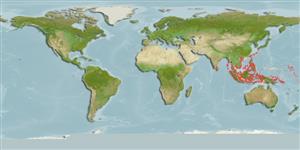>
Eupercaria/misc (Various families in series Eupercaria) >
Scaridae (Parrotfishes) > Scarinae
Etymology: Scarus: Greek, skaros = a fish described by anciente writers as a parrot fish; 1601 (Ref. 45335).
More on author: Bleeker.
Environment: milieu / climate zone / profondeur / distribution range
Écologie
marin récifal; profondeur 10 - 30 m (Ref. 90102). Tropical; 30°N - 9°S
Indo-Pacific: Moluccas in Indonesia, Philippines, Ryukyus in Japan and Palau.
Taille / Poids / Âge
Maturité: Lm ? range ? - ? cm
Max length : 31.0 cm TL mâle / non sexé; (Ref. 9710)
Épines dorsales (Total) : 9; Rayons mous dorsaux (Total) : 10; Épines anales: 3; Rayons mous anaux: 9. Males resemble S. bowersi but differs in that the tan area of S. bowersi does not extend as far back as the anal fin (Ref. 1602). Initial phase has a distinctive black spot at front of the anal fin and yellowish tail and soft dorsal fin.
Body shape (shape guide): elongated; Cross section: compressed.
A rare species found in coastal and outer reefs with dense coral cover (Ref. 9710); often silty habitats (Ref. 48636).
Life cycle and mating behavior
Maturité | Reproduction | Frai | Œufs | Fécondité | Larves
Oviparous, distinct pairing during breeding (Ref. 205).
Parenti, P. and J.E. Randall, 2000. An annotated checklist of the species of the labroid fish families Labridae and Scaridae. Ichthyol. Bull. J.L.B. Smith Inst. Ichthyol. (68):1-97. (Ref. 35918)
Statut dans la liste rouge de l'IUCN (Ref. 130435: Version 2025-1)
Menace pour l'homme
Harmless
Utilisations par l'homme
Pêcheries: commercial; Aquarium: Commercial
Outils
Articles particuliers
Télécharger en XML
Sources Internet
Estimates based on models
Preferred temperature (Réf.
123201): 25.4 - 29.1, mean 28.6 °C (based on 242 cells).
Phylogenetic diversity index (Réf.
82804): PD
50 = 0.5000 [Uniqueness, from 0.5 = low to 2.0 = high].
Bayesian length-weight: a=0.01000 (0.00422 - 0.02368), b=3.09 (2.90 - 3.28), in cm total length, based on LWR estimates for this Genus-body shape (Ref.
93245).
Résilience (Réf.
120179): Haut, temps minimum de doublement de population inférieur à 15 mois (Preliminary K or Fecundity.).
Fishing Vulnerability (Ref.
59153): Low vulnerability (21 of 100).
🛈
Nutrients (Ref.
124155): Calcium = 54.5 [30.3, 94.0] mg/100g; Iron = 0.771 [0.494, 1.316] mg/100g; Protein = 18.1 [15.9, 19.9] %; Omega3 = 0.0589 [, ] g/100g; Selenium = 21.2 [10.9, 39.2] μg/100g; VitaminA = 49.8 [12.3, 196.1] μg/100g; Zinc = 2.44 [1.74, 3.34] mg/100g (wet weight);
